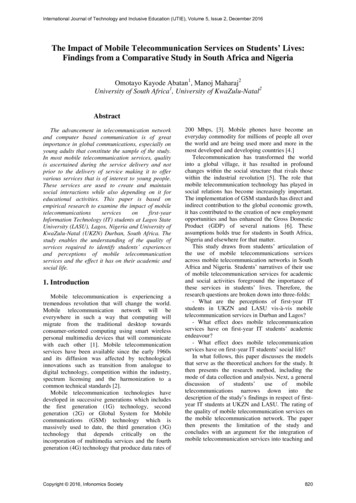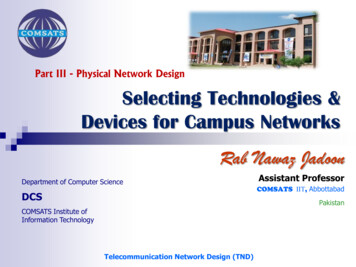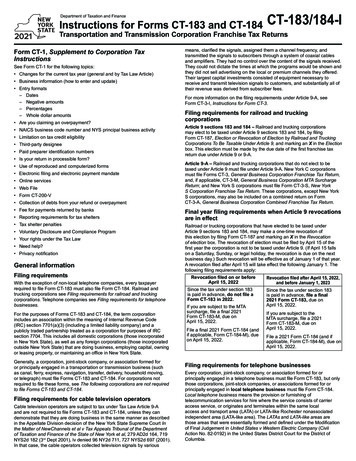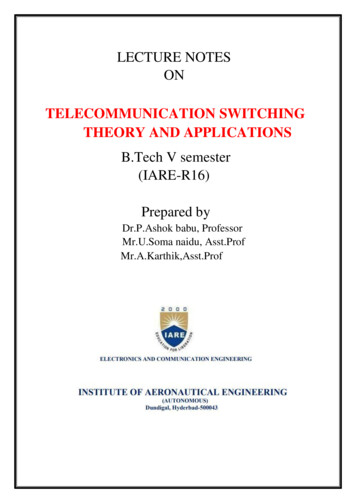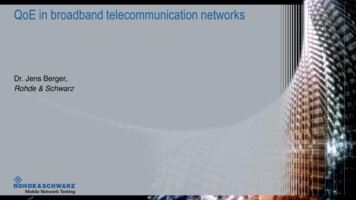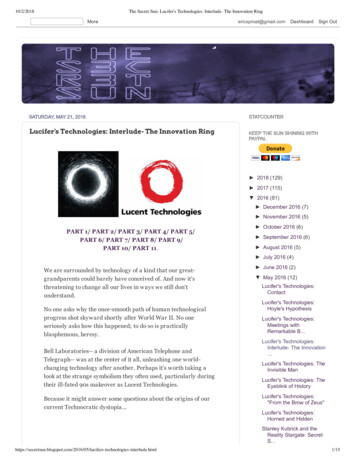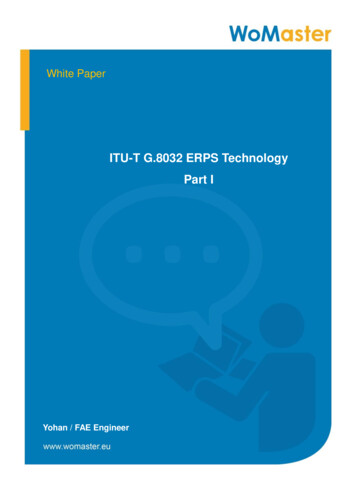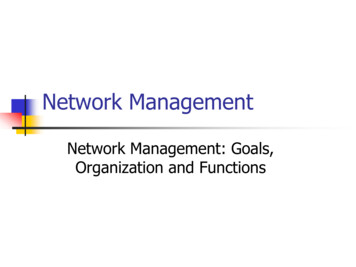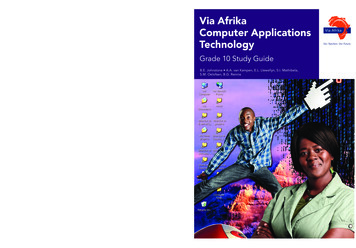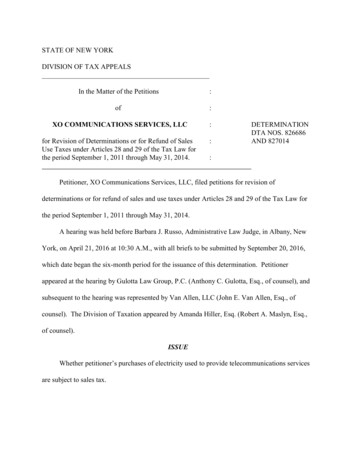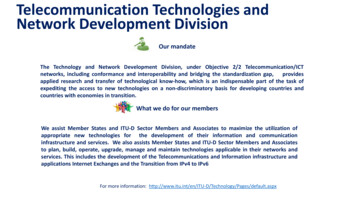
Transcription
Telecommunication Technologies andNetwork Development DivisionOur mandateThe Technology and Network Development Division, under Objective 2/2 Telecommunication/ICTnetworks, including conformance and interoperability and bridging the standardization gap,providesapplied research and transfer of technological know-how, which is an indispensable part of the task ofexpediting the access to new technologies on a non-discriminatory basis for developing countries andcountries with economies in transition.What we do for our membersWe assist Member States and ITU-D Sector Members and Associates to maximize the utilization ofappropriate new technologies for the development of their information and communicationinfrastructure and services. We also assists Member States and ITU-D Sector Members and Associatesto plan, build, operate, upgrade, manage and maintain technologies applicable in their networks andservices. This includes the development of the Telecommunications and Information infrastructure andapplications Internet Exchanges and the Transition from IPv4 to IPv6For more information: lt.aspx
Telecommunication Technologies andNetwork Development DivisionProjects in focusKey activitiesOur work is carried out by various means, including symposia, workshops, conferences, seminars and expert advice as well as informationsharing, creation of tools and training material, direct assistance, partnership, publications and events. Our priority areas are as follows:Next GenerationNetworks Next Generation Networks Conformity and Interoperability Mobile Communications Broadband Networks Rural Communications WSIS Action Line C2: Informationand Communication sRuralCommunications Conformity and Interoperability Assessment Study on Regional Basis:Collaboration with Regional and Subregional Organizations for establishing acommon C&I Regime and Mutual Recognition Agreements Training Activities on Conformance and Interoperability ITU-McCaw Foundation Broadband Wireless Network Project for Africa ITU Interactive Transmission Map
Telecommunication Technologies and NetworkDevelopment DivisionKey AreasProducts and Services in FocusOur work is carried out by various means, including symposia, workshops, conferences, seminars and expert advice as well as informationsharing, creation of tools and training material, direct assistance, partnership, publications and events. Our priority areas are as follows:Next GenerationNetworksMobileCommunicationsConformity tionsNext-Generation Networks: assistance on planning, deployment, migration,interoperatbility, digitization and evolution of networks, network elements andapplicationsBroadband Networks (wired and wireless technologies including IMT): assitance withplanning, implementation and development of national ICT broadband networks,including promoting IXPsRural communications: provision of information on access and backhaul technologiesand source of power supply, latest technologies and best practice, implementation ofprojects on public community broadband access pointsConformance and interoperability (C&I): assistance on the establishment of national,regional or subregional C&I programmes, assessment and feasibility studies, providinginformation and training to technicians, policy-makers and businesses on C&I,providing guidelines on C&IBridging the Standardization Gap: Increasing the knowledge and capacity ofdeveloping countries for the effective application/implementation of standardsdeveloped by ITU ITU Guidelines on Conformity and Interoperability: Different Guidelines relating tobest practice for planning and review of C&I regimes, Mutual RecognitionAgreements, establishment of C&I Test Labs and others ITU Trainings on C&I: provision of trainings to enhance knowledge, increaseawareness, promote experience sharing, present practical learning on standards,regulations, real lab experience and accreditation procedures; provision of Lectureon C&I Regimes; and C&I Testing Domains ITU C&I Regional Assessment Studies/ Conformity Interoperability Programme: topromote Harmonized C&I Programmes in collaboration with Regional Organizations ITU Broadband, IPv6 and Internet Exchange Implementations: to providebroadband connectivity free or low cost digital access for schools, hospitals,underserved populations; IXPs to reduce transmission costs, optimize Internet traffic,improve QoS ITU Interactive Transmission Maps: cutting-edge ICT-data mapping platform to takestock of national backbone connectivity and other key ICT metrics.
Priority areas Next-generation networks providing assistance to Member States on deployment and migration of their existing networks to NGN and further evolutions assisting countries in planning the introduction and continuous adoption of new network elements and applications by making use of specialized planning tools assisting countries in the digitization of analogue networks and in applying affordable wired and wireless technologies, including interoperability of ICTinfrastructure Broadband networks: Wired and wireless technologies, including IMT providing assistance to developing countries in their medium- to long-term planning for the implementation and development of national ICT broadbandnetwork plans collecting and disseminating information and analyses on the current status of broadband backbone and submarine cables, in order to assist members innetwork planning promoting Internet exchange points (IXPs) as a long-term solution to advance connectivity including the Transition from IPv4 to IPv6 Rural communications providing information on suitable technologies for access, backhaul and source of power supply to bring telecommunications to rural, unserved andunderserved areas implementing projects on public/community broadband access points, in close relation with local experts and communities themselves disseminating information and analyses of the latest technologies and best practices through methods such as publications, symposia, seminars and workshop, Conformance and interoperability (C&I) Conformance with international standards maximizes the probability that an ICT vendor's products will interoperate with those of other vendors educating technicians, policy-makers and businesses on the importance of C&I procedures and testing, mobilizing the resources required to implement regionaland national C&I programmes, in cooperation with other relevant regional and international organizations providing assistance to developing countries in the establishment of national, regional or subregional C&I programmes, and conducting assessment studies forfacilitating the establishment of common conformance and interoperability regimes at national, regional and subregional level preparing guidelines on this process which outline the technical and human resources required and the international standards to be applied
Tasks Creation of training material Creation of tools and Guidelines Assistance to members Information sharingThe tasks are carried out by variousmeans, including symposia, workshops,conferences, seminars and expert advice.Study Group Questions Question 1/1: Policy, regulatory and technical aspects of the migrationfrom existing networks to broadband networks in developingcountries, including next-generation networks, m-services, OTTservices and the implementation of IPv6 Question 2/1: Broadband access technologies, including IMT, fordeveloping countries; Question 5/1: Telecommunications/ICTs for rural and remote areas Question 4/2: Assistance to developing countries for implementingconformance and interoperability programmesRegional Initiatives AFR1: Strengthening human and institutional capacity building AFR3: Development of broadband access and adoption of broadband AMS3: Development of broadband access and adoption of broadband ARB1: Development of broadband access and adoption of broadband ASP3: Harnessing the benefits of new technologies ASP4: Development of broadband access and adoption of broadband CIS4: Development of broadband access and adoption of broadband EUR2: Development of broadband access and adoption of broadbandMain Activities (link) Training: Events and/or producing material Publications/Tools: Manuals, Guidelines, Case Studies Direct Assistance to members for all domains of competence (Network Engineering,Master Plan, etc) Projects: Managing and collaborating Partnerships: United Nation agencies, international and regional organizations Collaboration and sharing information with other BDT Divisions and with other ITUBureaux Collaboration with Regional Offices Focal Points for ITU-D SGs and WSISGuidelines Guidelines for developing countries on establishing conformity assessment test labsin different regions Guidelines for the development, implementation and management of MutualRecognition Agreements (MRAs) Feasibility Study for Conformance Testing Center Conformity and Interoperability assessment on Regional basis: Collaboration withRegional and Subregional Organizations for establishing a common C&I Regime andMutual Recognition Agreements Establishing Conformity and Interoperability Regimes: Basic GuidelinesComplete Guidelines Guidelines on the smooth transition of existing mobile networks to IMT-2000 fordeveloping countries (GST) Strategy for migration from existing networks to next-generation (NGN) fordeveloping countries (Final Report - Annexes) Guidelines for the preparation of N ational Wireless Broadband Masterplans for theAsia Pacific Region Report on implementation of evolving telecommunication/ICT infrastructure fordeveloping countries: Technical, economic and policy aspects
ITU C&I Programme To tackle different obstacles to the achievement ofconformity and interoperability, expressed by memberstates in ITU s Decisions.C&I Task ForceRegional Presence
Conformity Assessment benefits Conformity assessment builds consumers’ trust and confidence intested products and consequently strengthens businessenvironment and, thanks to interoperability, the economybenefits from business stability, scalability and cost reduction ofsystems, equipment and tariffs. While economically Conformance and Interoperability (C&I)increase market opportunities, encourage trade and technologytransfer and contribute to the removal of technical barriers, theysocially help spreading ICT services availability and affordabilityto all people at a good level of quality.
Telecommunication Technologies and NetworkDevelopment DivisionKey activitiesITU Trainings on Conformity an Interoperability MoUs signed with Testing Centers in the Regions topromote human capacity building in real testinglaboratories Objectives: Enhance knowledge; increase awareness;promote experience-sharing, present practicallearning on standards, regulations, real lab experienceand accreditation procedures Lectures on C&I Regimes (e.g. Regulatory framework,market surveillance); and C&I Testing Domains (e.g.mobile, EMC, broadband, and NGN)Projects in focus
ITU’s Decisions – C&I Action Plan Resolution 177 ITU Plenipotentiary Conference (PP-14)Resolution 47 ITU World Telecommunication DevelopmentConference (WTDC-10, rev. WTDC-14)Resolution 76 ITU World Telecommunication StandardizationAssembly (WTSA-08 rev. WTSA-12)Resolution 62 Radiocommunication Assembly (RA-2012, Rev.2015)ITU Council Decisions (2009, 2010, 2011,2012, 2013, 2014,2015)
“The ITU 4 Pillars”1 ConformanceAssessment2 InteroperabilityC&I3 CapacityBuilding4 Testing Centers(Labs/MRAs)
The ITU 4 “Pillars” The Standardization Sector Side Conformity Assessment Interoperability Events The Development Sector Side Capacity building Establishing C&I programmes in developingcountries
Capacity building and test centres ITU is implementing proposals on human capacitybuilding ITU will assist developing countries in theestablishment of test facilities and in cooperationwith international institutions: UNIDO International Laboratory AccreditationCooperation (ILAC) International Accreditation Forum (IAF), ) Labs and R&D institutions
The Telecommunication Development Bureau Side Capacity building Establishment of test centres and appropriateC&I Regimes including MRAs in developingcountries.ITU Forums with in-deep consideration for testcentres and Capacity Building in the RegionsHeld 2010 -2013: Africa (Kenya 2010, Ghana 2011) CIS (Moscow 2011) Americas (Brasilia 2012) Arab States (Tunis 2012) Forum and Training Asia Pacific (Myanmar 2013)Held 2014: CIS (Moscow)
Needs in Developing Countries for Test Labs and/or MRAs Conformity Assessment Bodies to contribute tocreate an orderly telecom apparatus market place Once reference standards and procedures are inplace, test labs and/or MRAs can approveequipment for compliance Sharing test labs resources and using sameprocedures amongst countries and regions maylowering overall costs while continuing addressingregional priorities A robust framework (following internationalprocedures – ISO/CASCO) needed for trust andconfidence in test results and among test labs(MRAs)
ITU Training activities on C&I – until 2014 CIS Countries NGN integration testing, Moscow (Russian Federation), 2010 and 2011 Africa and Arab Regions, Tunis 5-7 Nov 2012 ARB Region, Tunis 2-6 April 2013 (EMC Compatibility) Africa Region, Tunis 28 October-1st November 2013 (EMC Compatibility) Americas Region, Campinas, 24-28 June 2013 (EMC Compatibility) ARB Region, Tunis, 17-22 March 2014 (Mobile terminals) Americas Region, Campinas, 12-16 May 2014, (Mobile terminals) Training Course on Conformance and Interoperability Testing for the Africa Region, 2327 June 2014, Tunis (Tunisia) CIS Region: ITU Virtual Laboratory for Remote Tests of Equipment, New Technologiesand Services", 10-12 November 2014, Moscow (Russian Pages/CI Events.aspx
ITU Training activities on C&I for 2015 Training Course for the Arab Region on Type Approval Testing for MobileTerminals, Homologation Procedures and Market Surveillance, 20-24 April 2015,Tunis (Tunisia) Training Course for the Americas Region on Type Approval Testing for MobileTerminals, NGN integration and interoperability testing, HomologationProcedures and Market Surveillance, 8-12 June 2015, Campinas Training Course for CIS Region, Moscow, 7-9 July 2015 Training Course for ASP Centres of Excellence Region, Beijing, P.R. China 12-16October 2015 Training Course for the Africa Region on Type Approval Testing for MobileTerminals, Homologation Procedures and Market Surveillance, 14-18 /Pages/CI Events.aspx
Telecommunication Technologies and NetworkDevelopment DivisionKey activitiesProjects in focusITU Guidelines on Conformity and InteroperabilityEstablishing Conformity and InteroperabilityRegimes – Basic and Complete GuidelinesThese Guidelines compiled from a carefulcollection of international best practices,address challenges faced by developing countriesas they plan and review their own C&I regimesGuidelines for the Development,Implementation and Management of MRAsThese guidelines promote the understandingand establishment of Mutual RecognitionAgreements (MRAs) to promote efficiency andresource sharing of C&I related infrastructure,such as laboratories.Guidelines for developingcountries on Establishing Conformityassessment Test Labs in Different RegionsThese Guidelines includes: processes for buildingtesting labs; site analysis; collaborationmechanisms; best practices; reference standardsand ITU RecommendationsFeasibility Study for the establishment of aConformance Testing CentreThis feasibility study describes environments,procedures and methodologies to be adopted toestablish, manage and maintain a testing centerconformance and interoperability testing areas
Telecommunication Technologies and NetworkDevelopment DivisionITU C&I Regional Assessment Studies The C&I Assessment Studies looks for promoting the establishment of Harmonized C&I Programmes, collaborate to improve regionalintegration and fostering the availability of highly qualified institutions (as Laboratories, Certification and Accreditation Bodies) Activity conducted in close collaboration with Regional Organizations in addressing capacity building activities, accreditation and typeapproval testing for moving forward to establishing national, regional test centers and/or Mutual Recognition Agreements - MRAs asappropriateSADC RegionThe Southern AfricanDevelopment Community(SADC, 15 countries)Assessment Study tookplace in 2014. The resultswere presented in theSubregional Workshop forSADC, 13-15 October2014, Livingstone(Zambia).Caribbean countriesMaghreb RegionIn collaboration with theCaribbeanTelecommunication Union(CTU), the ITU C&IAssessment Study coveredthe Caribbean region in2014. The results werepresented in the SubregionalWorkshop for the Caribbean,2-4 December 2014, inTrinidad and TobagoMauritania, Morocco,Algeria, Tunisia, Libyaparticipated in the ITUAssessment Study forthe Maghreb Region.The results of the Studywere presented duringthe SubregionalWorkshop for MaghrebCountries, Tunis 9-11December 2014EAC countriesThe East AfricanCommunity (EAC) is theregional intergovernmentalorganization of the Republicof Burundi, Kenya, Rwanda,Tanzania, and Uganda. Theresults of the Study werepresented during theSubregional Workshop forEAC countries, NairobiOctober 2015COMTELCA Countries andCubaFor the Central Americancountries (Costa Rica,Dominican Republic, El Salvador,Guatemala, Honduras,Nicaragua, Panama and Cuba),the study is taking place in 2015.The results of the Study will bepresented during the ITU C&IWorkshop for COMTELCA andCuba, 7-9 December,Tegucigalpa, Honduras
C&I Regional Assessment StudiesThe C&I Assessment Studies looks for promoting theestablishment of Harmonized C&I Programmes, when possible.It will collaborate to improve regional integration and foster theavailability of highly qualified institutions (as Laboratories,Certification and Accreditation Bodies)In an overall analysis, the Assessment Studies contributes to:- Bridging the Standardization Gap,- reducing the Digital Divide, and- as is inherent to ICT technologies development, strengthensbusiness environment for global players.
C&I Regional Assessement Studies C&I infrastructure in regions/sub-regions/countries arebeing assessed Analysis of the status in the regions are being conducted Looking for promoting regional agreements aboutpossible locations for resources (Labs), agreements andtesting capabilities Close collaboration with regional experts in addressingcapacity building activities, accreditation and typeapproval testing. Moving forward to establishing regional test centersand/or MRAs as appropriate
C&I Regional Assessment StudiesCalendar Assessment Study for SADC Region completed 2014) The results of the Assessment Study have been presented during theSubregional Workshop for SADC (Southern African DevelopmentCommunity), 13-15 October 2014, Livingstone (Zambia)
C&I Assessment Study for SADC Final Report Survey Findings Outcomes of the Workshop for SADC, Livingstone,Zambia, 13-15 October, 2014 Recommendations: In Country C&I Test Lab Criteria for selecting countries for establishing regional testcentres Proposed plan for a SADC framework MRA Media statement on the meeting of SADC MinistersResponsible for Communications, Postal and ICTs. Mangochi,Malawi, 21 November 2014
Assessment Study for Maghreb countriesMauritania, Morocco, Algeria, Tunisia, Libya (completed 2014)The results of the assessment study have been presented during the SubregionalWorkshop for Maghreb Countries, Tunis 9-11 December 2014 Assessment Study for AMS (Caribbean) conducted in 2014, Assessment Studies for AMS(Central America) and AFR (EAC countries) are being conducted during 2015
C&I Assessment Study for Maghreb Final Report Survey Findings Outcomes of the workshop for Maghreb, Tunis9-11 December 2014 Recommendations: In Country C&I Test Lab Criteria for selecting countries for establishing regional testcentres Proposed plan for a Maghreb framework MRA
Follow-up of Assessment Study for Maghreb Joint declaration signed between ITU Regional Office of Cairoand UMA the Secretariat General of the Arab MaghrebUnion (UMA) for collaboration and support to Maghrebcountries for establishing a common MRA First meeting of C&I Expert Committee for Maghreb, Rabat(Morocco), 23-25 November 2015
Assessment Studies for the Caribbean The results of the first assessment were presented during the ITU C&IWorkshop for Caribbean (2-4 December 2014, in St. Augustine,Trinidad and Tobago) Assessment Study onC&I for theCaribbean Report es/Events.aspx
Follow-up of Assessment Study for the CaribbeanAs one of the results of the assessment and workshop held for theCaribbean was the cooperation between an ITU Academia member, CPqDwith Caribbean countries in regard to homologation and testing procedures.A high level Caribbean mission visited the laboratories of the CPqD inCampinas, Brazil, during the C&I training for the region in June 2015
Assessment Studies for EAC countries:The East African Community (EAC) is the regional intergovernmental organization of the Republics ofBurundi, Kenya, Rwanda, the United Republic of Tanzania, and the Republic of Uganda, with itsheadquarters in Arusha, Tanzania. (ongoing 2015)The results of the assessment study was presented during the Subregional Workshop for EACcountries, Nairobi 21-23 October 2015. EAC Secretariat will call for Ministerial Meeting early 2016
Assessment Studies Assessment Studies for Central America The results of the first assessment will be presented during the ITU C&IWorkshop for Central America Tegucigalpa, Honduras 7 – 9 December2015Costa RicaEl SalvadorGuatemalaHondurasNicaraguaPanamaDominican Republic Cuba
Follow-up of C&I Assessment Studies on Regional Basis SADC MaghrebFinal ReportSurvey FindingsOutcomes of the Workshop for SADC, Livingstone, Zambia, 13-15 October, 2014 Recommendations: In Country C&I Test Lab Criteria for selecting countries for establishing regional test centres Proposed plan for a SADC framework MRAMedia statement on the meeting of SADC Ministers Responsible for Communications, Postal and ICTs. Mangochi, Malawi, 21 November 2014 Final Report Survey Findings Outcomes of the workshop for Maghreb, Tunis 9-11 December 2014 Recommendations: In Country C&I Test Lab Criteria for selecting countries for establishing regional test centres Proposed plan for a Maghreb framework MRA Joint declaration signed between ITU Regional Office of Cairo and UMA the Secretariat General of the Arab MaghrebUnion (UMA) for collaboration and support to Maghreb countries for establishing a common MRA First meeting of C&I Expert Committee for Maghreb, Rabat (Marocco), 23-25 November 2015CaribbeanEAC As one of the results of the assessment and workshop held for the Caribbean was the cooperation between an ITUAcademia member, CPqD with Caribbean countries in regard to homologation and testing procedures. A high levelCaribbean mission visited the laboratories of the CPqD in Campinas, Brazil, during the C&I training for the region inJune 2015 C&I Assessment Study for EAC: Survey Findings Outc omes Recommendations: In Country C&I Test Lab Criteria for selec ting countries for establishing regional test centres Proposed plan for EAC fra mework MRA EAC Task Force on Conformity and Interoperability (C&I): Terms of Reference
Direct Assistance on C&IA number of countries have expressed strong interest and requesteddirect assistance (e.g. Sri-Lanka, Kiribati, Mongolia, Zambia, Cameroon,Cote d’Ivoire, Ghana) in establishing C&I infrastructure and proceduresThe Direct Assistance provided through the Regional Offices will providesupport taken into consideration all C&I aspects, as: Regulatory framework Institutions roles and typical procedures Mutual Recognition Agreements Funding National and Regional test centres and harmonized C&Iprogrammes: Roadmap and Feasibility Study
Telecommunication Technologies and NetworkDevelopment DivisionBridging the Standardization Gap Standardization capabilities contributes to reduce the digital dividebetween the developed and developing worlds. The activities from ITU Regional Offices and Areas Offices is key. Tailoredcapacity building events and assistance to developing countries willincrease inputs from developing countries into ICT standards. WTDC-14, Dubai, highlighted the relevance of regional activities andengagement on bridging the standardization gap between developing anddeveloped countries. The Dubai Declaration specifically asserts that “increased participation ofdeveloping countries in ITU activities to bridge the standardization gap isneeded to ensure that they experience the economic benefits associatedwith technological development, and to better reflect the requirementsand interests of developing countries in this area;” Fostering “the development of telecommunication/ICT networks as well as relevant applications and services, including bridging the standardizationgap” is the new ITU-D Objective 2; Approval of the Recommendation ITU-D 22 , “Bridging the standardizationgap in association with regional groups of the study groups.”Programme: Telecommunication/ICT networks, includingconformance and interoperability and bridging thestandardization gap: The objective of BDT's work in this areais to assist Member States in the implementation ofevolution to these future network architectures andtechnologies, in accordance with the applicable standards(Recommendations) developed in ITU-T and ITU-R, forbridging the standardization gap, making better use of andmanaging infrastructure and resources as well as addressinginterconnection issues of emerging networks.Resolution 47 on the enhancement of knowledge andeffective application of ITU Recommendations in developingcountries, was revised to stress of the usefulness of ITUguidelines on the application of ITU Recommendations;
BDT activities in BSGIn collaboration with Regional Offices, BDT coordination toorganize Regional Standardization Forums: ITU Regional Standardization Forum for Americas, 21September 2015, Washington D.C., United States ITU Regional Standardization Forum for Asia Pacific region,27-28 October 2015, Jakarta, IndonesiaAnd capacity building events available at ITU Academy (e.g.Working Methods of ITU-T Study Groups; an training on NGNhas been planned).
ITU-D Study Group QuestionsQuestion 1/1: Policy, regulatory and technical aspects of the migration from existingnetworks to broadband networks in developing countries, including next-generationnetworks, m-services, OTT services and the implementation of IPv6Question 2/1: Broadband access technologies, including IMT, fordeveloping countriesQuestion 5/1: Telecommunications/ICTs for rural and remoteQuestion 4/2: Assistance to developing countries for implementingconformance and interoperability programmes
Question 4/2: Assistance to developing countries forimplementing conformance and interoperability programmes35
WTDC-14 outcomes on C&I The Dubai Declaration recognized thatconformance and interoperability oftelecommunication/ ICT equipment andsystems can increase market opportunitiesand reliability and encourage globalintegration and trade. Resolution 47 was amended, reaffirmingthe importance of collaboration andcoordination between the three ITUBureaux in implementing the ITU C&Iprogramme.
WTDC-14 outcomes on C&I Study Group Question 4/2, mandate:“Studies of various issues related to conformance andinteroperability are to be reported, and among others thedescription of the technical, legislative and regulatoryframework that would be needed to implementappropriate C&I programmes by developing countries.Specifically, the following outputs are envisaged: a) Harmonized Guidelines on technical, legal andregulatory aspects of C&I Regime; b) Feasibility studies regarding establishment oflaboratories in different C&I Domains;MRA;c) Guidance on the framework and procedures to establish d) C&I Regimes, case studies established at national,regional or global levels; e) Development of a methodology for assessing thesituation of C&I regimes in place in the regions (or sub regions); f) Experience sharing and case studies reports on C&Iprogrammes implementation.”
WTDC-14 outcomes on C&IOutcomes of Objective 2, Output 2.2 of the Dubai Action Plan,focusing on the following issues:a) Educating technicians, policy-makers andbusinesses on the importance of C&I proceduresand testing, mobilizing the resources required toimplement regional and national C&I programmes,in cooperation with other relevant regional andinternational organizations; b) Providing assistance to developing countriesin the establishment of national, regional orsubregional C&I programmes, and conductingassessment studies for facilitating the establishmentof common conformance and interoperabilityregimes at national, regional and subregional level; c) Preparing guidelines on this process whichoutline the technical and human resources requiredand the international standards to be applied.
ITU-D Q.1/1 – Migration to BroadbandNetworks Q1.1: Policy, regulatory and technical aspects of the migration from existing networks tobroadband networks in developing countries, including next-generation networks, mservices, OTT services and the implementation of IPv6 New report on Implementation of Evolving Telecommunication/ICT Infrastructure forDeveloping Countries has been finalize
Telecommunication Technologies and Network Development Division Key Areas Products and Services in Focus Our work is carried out by various means, including symposia, workshops, conferences, seminars and expert advice as well as information
